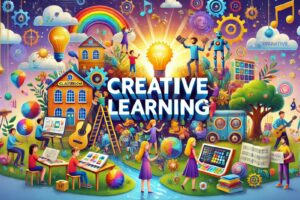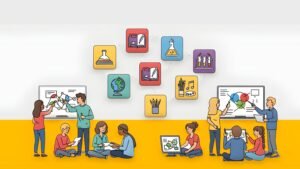Introduction to Technology in Early Childhood Education
In recent years, technology has become an integral aspect of early childhood education, transforming how educators approach learning and development for young children. The increasing presence of digital tools and resources, such as tablets, interactive whiteboards, and educational software, offers educators innovative ways to engage children in the learning process. These advancements allow for a more dynamic, interactive, and diverse approach to education, facilitating a unique learning environment that resonates with today’s tech-savvy youth.
Incorporating technology into early childhood curricula can provide numerous benefits. For instance, it can enhance cognitive skills, promote problem-solving abilities, and support social interactions among peers. Applications designed specifically for young learners often encourage collaborative play, fostering communication and teamwork. Furthermore, technology can cater to various learning styles, allowing educators to individualize lessons to meet diverse needs, thereby ensuring that every child has the opportunity to thrive within the educational framework.
Despite common misconceptions about screen time and its effects on young children, research suggests that, when used appropriately, educational technology can complement traditional learning methods rather than replace them. Educators and parents can help maximize the benefits of technology by engaging with children while they use these tools. This dual involvement enhances the learning experience, as children gain guidance and context for their digital activities. Additionally, educators can provide structured opportunities for technology use, ensuring that it aligns with age-appropriate learning objectives and promotes skill development.
By effectively integrating technology into early childhood education, educators can create enriched learning experiences that prepare children for future academic success while also laying a strong foundation for lifelong learning.
Types of Technology Used in Early Childhood Education
In the rapidly evolving landscape of early childhood education, diverse types of technology are employed to enhance learning and development among young learners. Interactive educational apps stand out as one of the most prevalent tools. These applications, designed for tablets and smartphones, offer engaging experiences that promote literacy and numeracy skills while making learning enjoyable. For example, apps like “Endless Alphabet” and “Starfall” integrate games and storytelling to foster a love for reading and exploration of letters and sounds.
Moreover, multimedia resources such as videos, animations, and interactive storytelling platforms play a significant role in early education. Utilizing videos and animated content can ignite children’s imagination, helping them to comprehend complex concepts through visuals. Platforms like “PBS Kids” and “National Geographic Kids” deliver educational content in a captivating format, targeting various developmental areas, including social skills and creativity.
Virtual learning environments (VLEs) are also becoming increasingly common in early childhood education. These platforms provide a space for educators and children to interact in real-time, allowing for greater flexibility and accessibility. Websites like “Seesaw” enable teachers to share assignments, track progress, and engage parents, thereby fostering a collaborative approach to learning, even from a distance.
Additionally, programmable toys such as “LEGO Boost” and “Botley the Coding Robot” introduce children to the basics of programming and problem-solving. These tools encourage creativity as children use their imagination to build and manipulate objects, promoting fine motor skills and logical thinking. By integrating these various forms of technology, educators and parents can enhance children’s learning experiences across critical developmental areas, establishing a solid foundation for their future educational journeys.
Benefits of Technology in Early Learning
The integration of technology into early childhood education offers numerous advantages that significantly enhance the learning experience for young children. One of the primary benefits is the increased engagement and motivation it fosters among learners. Interactive digital tools, such as educational apps and games, capture children’s attention and encourage participation. These tools often utilize bright colors, stimulating sound effects, and captivating narratives, which can make learning feel more like play, thus motivating young learners to explore and discover new concepts.
Technology also allows for tailored learning experiences that cater to the diverse learning styles and needs of children. For instance, adaptive learning technologies can assess a child’s progress and provide individualized feedback, helping teachers to more effectively support each student’s development. This customized approach ensures that children who may struggle with traditional learning methods can benefit from alternative strategies, enhancing their overall educational outcome.
Moreover, the incorporation of technology helps children develop critical digital literacy skills that are essential in today’s increasingly digital world. Exposure to technology at an early age prepares children to navigate various digital environments comfortably and competently. As they interact with technology, children learn how to utilize various tools for information gathering, communication, and creative expression, which are foundational skills for future learning and professional opportunities.
Research supports the positive impact of technology on cognitive development and social interaction among young children. Studies indicate that when technology is thoughtfully integrated into early childhood education, it can boost cognitive skills such as problem-solving and critical thinking. Furthermore, collaborative technology-based projects encourage social interaction, allowing children to work together and learn from one another in inclusive environments. Overall, the thoughtful integration of technology is essential for fostering a rich educational landscape for early learners.
Challenges and Considerations for Educators and Parents
The integration of technology in early childhood education brings forth various challenges that both educators and parents must navigate. One of the predominant concerns is screen time. The American Academy of Pediatrics recommends that children aged 2 to 5 should have no more than one hour of high-quality programming each day. Excessive screen time can lead to negative impacts on a child’s physical health, social skills, and overall development. Therefore, finding the right balance between digital engagement and physical activities is imperative for fostering a holistic learning environment.
Moreover, the importance of age-appropriate technology cannot be overstated. Many educational apps and games are designed specifically for young learners, yet not all digital tools are suitable for every developmental stage. Educators and parents must be diligent in selecting technology that aligns with the children’s developmental milestones, enhancing cognitive skills while minimizing potential distractions and negative influences. This calls for a collective effort to educate families about the implications of technology use and the criteria for selecting suitable content.
Additionally, fostering a productive dialogue between educators and parents regarding technology use is essential. Educators should provide resources and guidance on effectively integrating technology into classroom settings while encouraging parents to adopt similar practices at home. This collaborative approach ensures consistency and reinforces the learning objectives established in educational settings. By establishing clear guidelines and expectations, both parties can better support children’s learning experiences, promoting critical thinking and creativity while mitigating risks associated with unregulated technology use.
In conclusion, addressing the challenges related to technology in early childhood education requires careful consideration and proactive strategies from both educators and parents. By prioritizing balanced technology integration, fostering open communication, and making informed choices, stakeholders can effectively harness the benefits of technology while safeguarding the developmental needs of young learners.






















